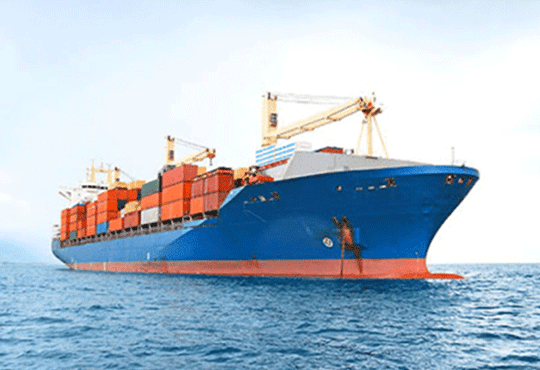
Ensuring Security & Reliability in Autonomous Ship Operations
Roshan Akthar, Content Writer | Friday, 09 February 2024, 14:10 IST
 Automation in the maritime industry signifies a transformative move towards effectiveness, security, and supportability. By consolidating progressed advances such as autonomous vessels, smart navigation systems, and computerized cargo taking care of the industry aims to streamline operations. This not only reduces human error but also updates generally security guidelines. Additionally, automation enables continuous monitoring and data analysis, optimizing fuel utilization and natural effect. The significance lies in revolutionizing traditional maritime practices, fostering a more versatile and cost-effective industry that adjusts to the requests of the advanced world whereas prioritizing safety and environmental considerations.
Automation in the maritime industry signifies a transformative move towards effectiveness, security, and supportability. By consolidating progressed advances such as autonomous vessels, smart navigation systems, and computerized cargo taking care of the industry aims to streamline operations. This not only reduces human error but also updates generally security guidelines. Additionally, automation enables continuous monitoring and data analysis, optimizing fuel utilization and natural effect. The significance lies in revolutionizing traditional maritime practices, fostering a more versatile and cost-effective industry that adjusts to the requests of the advanced world whereas prioritizing safety and environmental considerations.
History of Automation in Shipping
The historical context of automation in shipping follows back to the Industrial Revolution when steam-powered vessels revolutionized sea transportation. In the late 19th century, the presentation of telecommunication encouraged communication between ships and shore, upgrading routes. The mid-20th century saw the appearance of containerization, streamlining cargo handling. Automation picked upenergy within the late 20th century with computerized route framework and mechanized cargo stacking. In recent years, innovations like independent vessels and savvy ports are reshaping the industry. This advancement reflects a continuous pursuit of efficiency, safety, and cost-effectiveness, forming the maritime landscape through the focal point of automation.
The Benefits of Streamlining Operations
Enhanced Efficiency:
Streamlining operations is an essential technique that fosters upgraded proficiency over various trade functions. By recognizing and eliminating redundant processes, organizations can streamline workflows, allowing for smoother and faster operations. This improved efficiency not only accelerates the pace of daily tasks but too contributes to improved overall productivity.
Technology Integration:
The integration of cutting-edge technologies plays aurgent part in operational streamlining. Automation, artificial intelligence, and information analytics empower organizations to robotize repetitive tasks, make data-driven choices, and pick up profitable bits of knowledge. This integration not only speeds up forms but also minimizes the probability of blunders, thereby further improving efficiency.
Improved Collaboration:
Streamlining operations regularly includes breaking down silos inside an organization. Improved collaboration between distinctive departments and group fosters a cohesive work environment. With streamlined communication channels and shared assets, representative can collaborate consistently, driving to faster decision-making and upgraded overall efficiency.
Resource Optimization: Efficient operations involve ideal utilization of assets, including human capital and physical resources. Through careful analysis of resource allocation and request determining, organizations can maintain astrategic distance from overstaffing or resources, coming about in significant cost savings.
"With the innovation of IoT in the last couple of years, the auto industry is certainly one of the top adopters of the technology; leveraging it mainly for promising safety, preventive maintenance, and other infotainment purposes"
The Use of Autonomous Vessels and their Impact on Shipping Logistics
Autonomous vessels, moreover known as unmanned or independent ships, are changing the scene of shipping coordination. These mechanically progressed sea vehicles operate without onboard human team, depending on advanced sensors, artificial intelligence, and communication systems to explore and make choices. The impact of autonomous vessels on shipping coordination is multifaceted, including efficiency enhancement, administrative challenges and natural implications.
Drones in Maritime Operations
In oceanic observation, drones gives a cost-effective arrangement for monitoring endless ocean regions. Prepared with high-resolution cameras and advanced sensors, they can distinguish unlawful exercises such as robbery, sneaking, or unauthorized angling. Additionally, drones can cover broad areas rapidly, allowing for timely response to potential dangers. Security at ocean is significantly improved through the use of drones. They can be sent to help in search and protect operations, giving real-time airborne sees to find lost vessels or people. Drones equipped with thermal imaging innovation enhance their viability in finding survivors during nighttime or antagonistic weather conditions.
Natural Checking is another basic application of drones in sea operations. These unmanned vehicles can survey oil spills, screen marine life and collect information on water quality. By encouraging fast reaction to environmental incidents, drones contribute to the security and conservation of marine biological systems.
Highlight the Role of Drones in Surveillance and Data collection
Drones have revolutionized surveillance and information collection, advertising phenomenal capabilities in various areas. In law authorization, they provide aerial perspectives for checking open spaces, following criminal exercises and upgrading generally security. Furthermore, in agribusiness, drones enable precision farming by collecting information on trim wellbeing, optimizing resource utilization and boosting yields.
Furthermore, the military utilizes rambles for reconnaissance, insights gathering, and target identification, reducing the requirement for human presence in high-risk zones. The real-time data given by drones upgrades situational awareness, aiding in strategic decision-making during operations. Within the private sector, companies utilize drones for studying, mapping, and framework review. These applications not as it were spare time and costs but to move forward security by avoiding the need for human workers to get to unsafe environments.
Within the sea segment, independent ships prepared with advanced navigation systems, artificial intelligence (AI), and sensor technologies are making waves. These vessels can work with negligible human mediation, diminishing the hazard of mischances and bringing down operational costs. One outstanding improvement is the implementation of independent navigation systems using real-time information investigation. These frameworks coordinated sensors like radar, lidar, and cameras to identify and react to encompassing conditions, empowering autonomous ships to explore complex waterways and avoid obstacles. Machine learning calculations upgrade decision-making, adapting to changing situations and optimizing courses for fuel efficiency.
Within the drone industry, computerization innovations have transformed aerial operations over different divisions, from surveillance and agriculture to delivery services. Drones prepared with advanced sensors and AI algorithms can perform tasks such as edit observing, mapping, and search and rescue missions with enhanced accuracy.
Insights into the Future of Automation in the Maritime Industry
The future of automation within the maritime industry is balanced for noteworthy headways. Autonomous ships, powered by AI and sensor technologies, are anticipated to streamline operations, diminish human blunder, and upgrade safety. Smart navigation systems, automated cargo handling, and predictive maintenance will ended up indispensably, making strides productivity and lessening operational costs. However, challenges like administrative systems, cyber security, and societal acceptance need addressing for widespread adoption. Generally, automation guarantees to revolutionize the sea division, making it more efficient, feasible, and mechanically progressed.
Emphasize the positive impact of embracing automation in ships & drones.
Automation optimizes route, permitting for exact courses and smoother operations, eventually driving to taken a troll reserved funds and improved resource utilization. Also, it contributes to natural sustainability by optimizing fuel utilization and minimizing outflows. Overall, grasping automation in maritime and aerial vehicles propels innovation, making transportation more dependable, economical, and naturally neighborly.
CIO Viewpoint
Technology Partner and Business Growth
By Mehdihasan Naqvi, Head IT, Otis Elevator Company
"Technology Partner" - in today's dynamic business
By Uday Sakunala, Head-IT, Hexagon Capability Center India
Collaborating with Technology Partners for...
By Joseph Kiran Kumar, Director and Head- IT, Eisai Pharmaceuticals India Pvt. Ltd
CXO Insights
How Low-Code is Transforming the Future of Work...
By Deepak Pargaonkar, VP, Solution Engineering, Salesforce India
By Suresh .V. Menon – Principal Consultant on Six Sigma and Strategic Management.
Ecosystem innovation: an enabler for digital...







